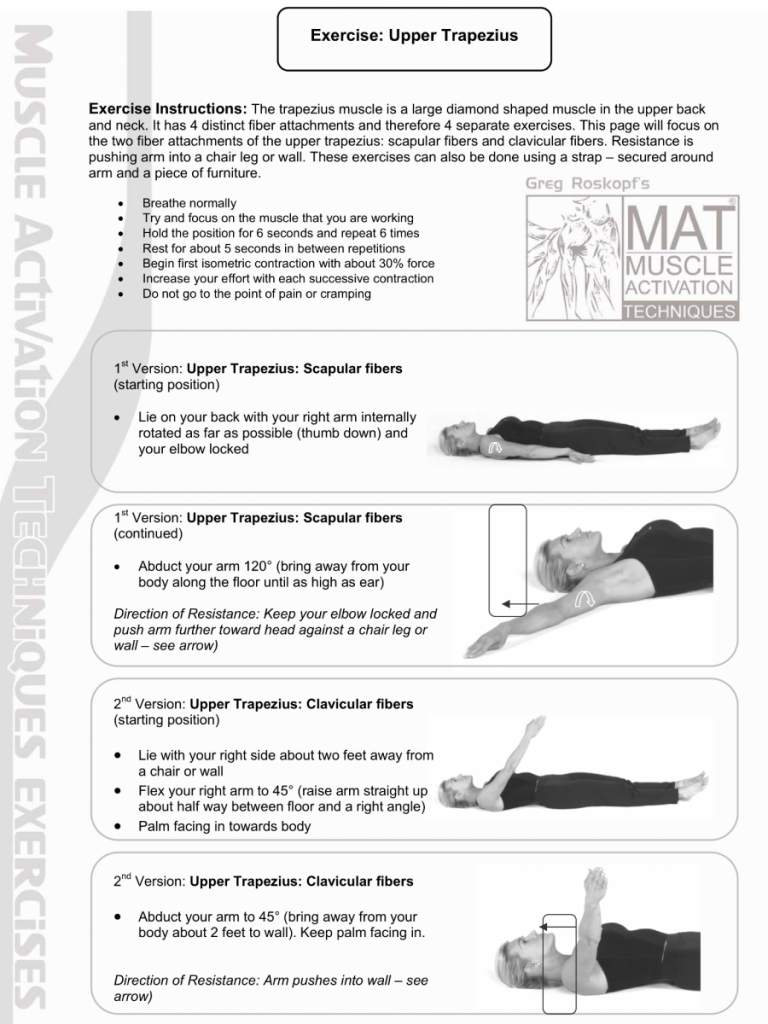In this post we look at exercises to help rehab the 3 most common triathlon injuries.

Let me start this post by expressing my respect for anybody who would be mad enough to participate in a sport that combined swimming, cycling and running.
As a former cyclist I can say the last thing on my mind when I finished a bike race was going for a run. Most of the time walking was challenging enough. I certainly never prefaced any bike race with swim either. Not intentionally in any case.
Speaking to triathlon coaches recently, it seems there are common themes regarding the injuries most frequently encountered in this sport.
In this post we’ll discuss exercises that will help rehab the 3 most common triathlon injuries using the Muscle Activation Techniques (MAT) thought process. I’ll include one key exercise for each injury that you can incorporate directly into your training and rehab.
Keeping true to the theme, let’s run through them in event order.
Swimming injuries
Far and away the most common injury suffered in the water is the aptly named swimmer’s shoulder. This injury usually describes a situation where a tendon of the rotator cuff, the long head biceps tendon, or the subacromial bursa gets impinged under the acromion process (see below).

Due to the repetitive nature of swimming, over time this can result in the degradation of those tendons and potentially pain.
The cause of this impingement is a hot topic. Some studies have found weakness in the humeral external rotators to be associated with this injury. Whilst others have suggested it’s caused by weakness in the humeral internal rotators.
Naturally, as we are a little counter culture, I’m going to give you a different perspective.
Imagine for a second you are stuck in a door. Try as you might to rotate left or right, you can’t escape. What is the primary issue here? Is it that you don’t have enough rotation to the left or right? Or is it that the door won’t open wider?
I guess you think opening the door wider would help.
This analogy translates directly to swimmer’s shoulder, with the acromion replacing the door. It doesn’t really matter which thing keeps getting stuck in the door, get the door to open a little wider and in most cases that will help.
How do you do that?
An open door in this instance means a scapula that is able to achieve full upward rotation.
The problem with giving specific advice on how to achieve this is that several muscles act on the scapula to enable this. These include serratus anterior and all three divisions of the trapezius muscle. Weakness in any one of them can impact this motion.
Try these specific exercises for upper trapezius. The majority of swimmers I see with shoulder impingment have weakness in this muscle and benefit greatly from this exercise.

Cycling injuries
Here’s my favourite for the reasons already mentioned. Whilst there are usually lower back and neck issues associated with cycling for long periods, most triathlons are short enough to avoid these.
Knee issues are certainly something that will keep you off the bike however.
Think of the knee as a solid hinge, with the majority of the motion available being flexion and extension. It’s not usually down to the knee when things go wrong therefore. But rather weakness in the muscles that control the joints either above or below.
As cycling doesn’t involve direct contact with the ground at the foot, I usually look first at the hip when knee problems arise in bike riders.
Why your hips are important
Weakness at the hip can set your knees up for problems because it impacts how the knee tracks. This influences how the forces are distributed as you cycle.
If for example you have weakness in the lateral muscles of your hip, you may notice your knee moves closer to the crossbar at the top of the pedal stroke when compared to the other side.
Whilst not necessarily an issue in the short term, over time this may irritate the structures of the knee. Imagine bending a hinge repeatedly but also twisting it a little at the same time and you get the picture.
Rather like the previous issue, there is not necessarily a one exercise solution unfortunately. If your knee problem is being caused by weakness in the lateral hip muscles however, these exercises below will help.

Running injuries
Last but not least the run. This is certainly the most likely cause of injury for any triathlete because running places the largest forces on the body.
You will be receiving upwards of 2-3 times your body weight through each leg every time your foot hits the ground. Even for somebody as svelte as Alistair Brownlee, that’s the equivalent of over 150 kgs with every stride.
The majority of the work taking place is concentrated around the lower leg, with the plantarflexors (calves) contributing to over 50% of the running motion, the quads 30% and the glutes 15%.
This largely explains why injuries to the lower leg are so common, with Achilles tendon issues being the most frequent injury encountered.
Achilles tendinopathies warrant a separate post altogether.
Suffice to say that rest, stretching and generally anything passive that’s applied to you, such as massage or shock wave therapy for example, may not provide a long term solution.
The reason for this is the underlying cause, muscle weakness. In order to get better you need to strengthen everything that plantarflexes the ankle.
That includes the soleus, gastrocnemius, (which both attach into the Achilles’ tendon) as well as posterior tibialis, peroneus longus, peroneus brevis, flexor hallucis longus and flexor digitorum longus.
Summary
If you’d like to know more about how Muscle Activation Techniques (MAT) can help you both recover from chronic injuries and improve your performance, book a Discovery Session.